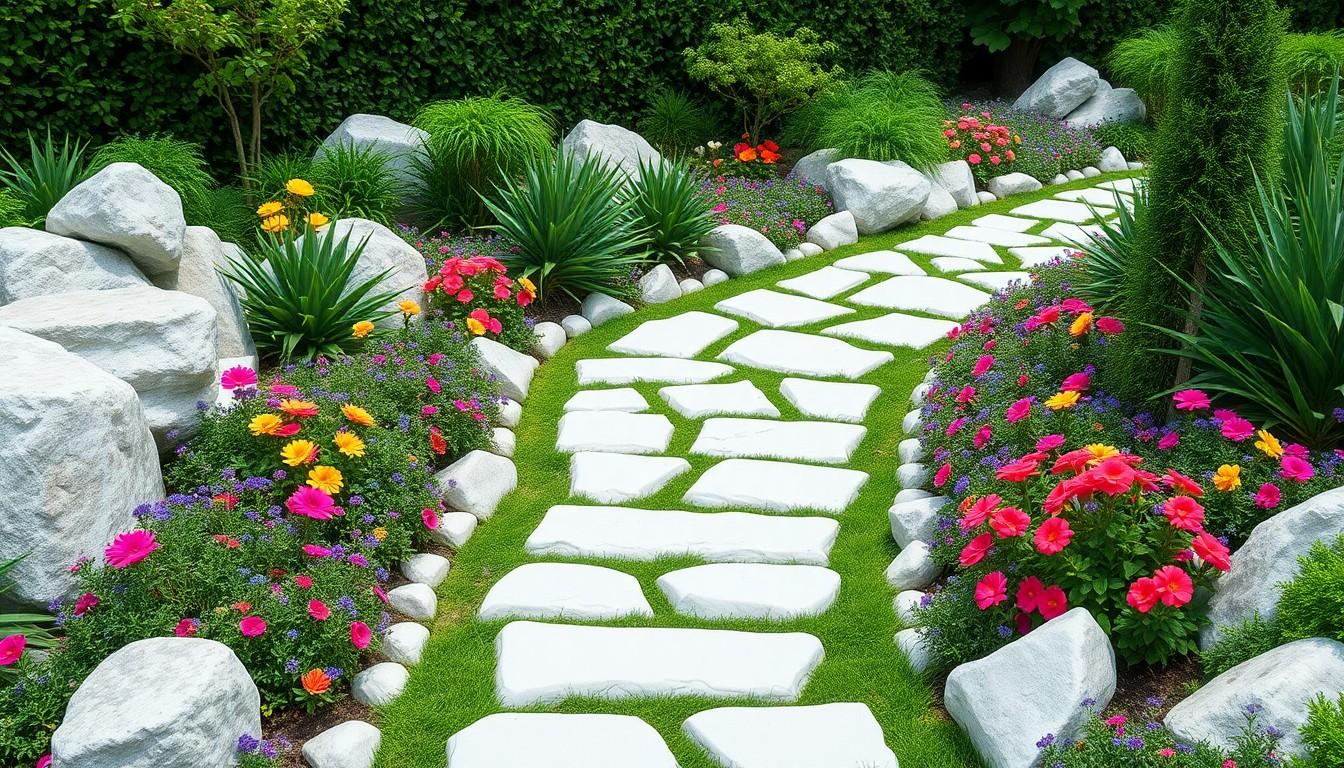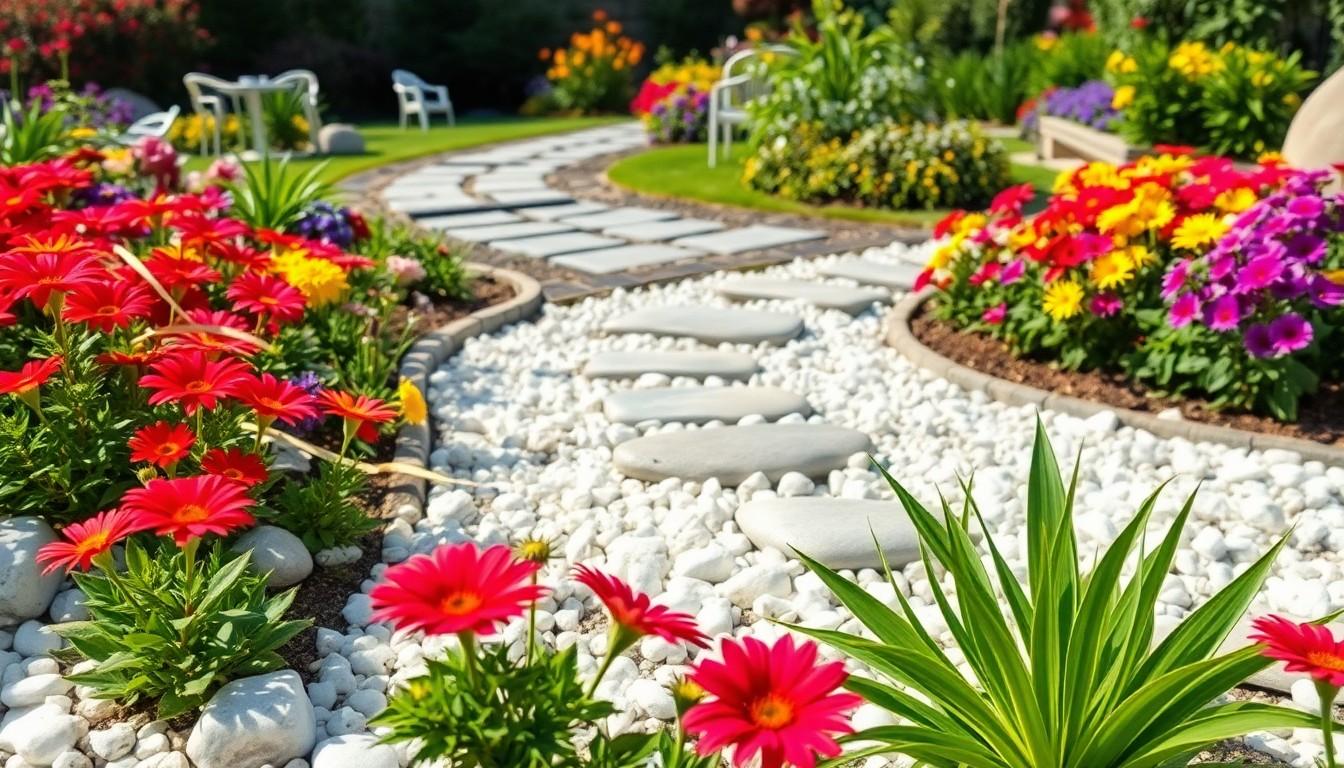When it comes to landscaping, white rock is the unsung hero that can transform any outdoor space from drab to fab faster than you can say “curb appeal.” Imagine a pristine blanket of white stones glistening under the sun, creating a stunning contrast against vibrant flowers and lush greenery. It’s like nature’s own version of a chic accessory that never goes out of style.
White Rock for Landscaping
White rock serves as an exceptional choice for landscaping, providing versatility and visual appeal. It enhances garden beds, pathways, and decorative features, contributing a clean, modern look. The stones come in various shapes and sizes, allowing for tailored designs suited to different outdoor themes.
A major benefit includes weed suppression, as white rock prevents sunlight from reaching the soil, reducing unwanted plant growth. Durability stands out; these stones resist fading and deterioration, ensuring long-lasting beauty. Maintenance involves occasional rinsing to remove dust and debris, making it a practical option for busy homeowners.
White rock’s reflective properties enhance light in shaded areas, creating a brighter environment. Pairing stones with vibrant plants creates striking contrasts, adding depth and interest to landscapes. Used alongside other materials like wood or metal, white rock complements diverse styles.
Cost-effective solutions exist within this category, with prices varying based on size and quality. Homeowners can find white rock in local garden centers or online retailers, making procurement easy. Its sustainable nature appeals to eco-conscious individuals seeking alternatives to grass or mulch.
Overall, the application of white rock in landscaping provides unique aesthetic advantages and practical benefits, making it an increasingly popular choice among landscape designers and homeowners alike.
Benefits of Using White Rock

White rock offers numerous advantages for landscaping design. Its contributions to aesthetic appeal and durability make it a favored choice among homeowners and designers.
Aesthetic Appeal
Visually striking, white rock enhances outdoor spaces immediately. The bright color provides a stunning contrast against vibrant flowers and lush greenery. Various shapes and sizes allow for versatile designs that suit different themes. Incorporating white stones promotes a clean, modern look in gardens and pathways. Reflective properties also brighten shaded areas, creating a welcoming ambiance in any landscape. These features enable white rock to serve as both a foundation and a focal point, elevating the overall visual impact.
Durability and Longevity
Durability sets white rock apart from other landscaping materials. Resistant to wear, the stones do not fade or break down easily under weather conditions. Their longevity reduces the need for frequent replacement, making them a practical choice. Low maintenance is another significant benefit, as white rocks do not require regular upkeep beyond occasional cleaning. This characteristic suits busy homeowners who prefer a hassle-free landscaping solution. The long-lasting nature of white rock ensures that outdoor spaces remain attractive for years, providing both beauty and functionality.
Types of White Rock
White rock comes in various forms, each offering unique characteristics suited for landscaping needs.
Crushed Stone
Crushed stone serves as a popular choice among landscapers. It consists of small, angular fragments that create a rough texture. This type provides excellent drainage, ensuring water flows away easily. Various sizes are available, ranging from fine particles to larger gravel. Selecting the right size for specific projects enhances functionality and aesthetics. Color variations in crushed stone maintain a bright appearance, remaining visually stunning against vibrant plants. Homeowners often use crushed stone for pathways and borders, adding a clean, defined line to garden beds.
River Rock
River rock features smooth, rounded stones that add an organic feel to landscapes. This type stands out due to its natural appearance, blending harmoniously with diverse outdoor settings. Available in multiple sizes, river rock accommodates various landscaping needs, from decorative features to drainage solutions. Reflective surfaces of these stones contribute to brightness in shaded areas. Patios and garden borders benefit significantly from the fluid look of river rock. Homeowners appreciate its capacity to suppress weeds while minimizing maintenance, making it a practical yet stylish choice for any outdoor space.
Best Practices for Using White Rock in Landscaping
Using white rock effectively enhances outdoor spaces. Implementing the right techniques maximizes its visual and practical benefits.
Installation Techniques
Begin with proper site preparation to achieve a clean, level surface. This prevents weeds and ensures stability. Using landscape fabric underneath white rock minimizes weed growth while allowing drainage. Spread the rock evenly, maintaining a depth of at least 2 to 3 inches for optimal coverage and effectiveness. Create defined borders with edging materials to keep stones in place. For pathways, ensure a compacted base to prevent shifting. Group larger stones in clusters for visual interest, and consider mixing sizes for a natural appearance. Install white rock in areas with sufficient drainage to prevent muddiness and maintain its aesthetic appeal.
Maintenance Tips
Regular upkeep keeps white rock looking fresh and appealing. Rinse stones periodically to remove dust and debris. This maintains their bright appearance and prevents discoloration over time. Check for weeds occasionally; pulling any visible growth helps maintain cleanliness. Consider replenishing the rocks every few years to fill in areas where stones have settled or been displaced. Choosing the right tools for maintenance, such as a leaf blower or rake, simplifies the cleaning process. Adjusting the placement of larger stones can also revitalize the overall look of landscaped areas.
Environmental Considerations
Selecting white rock for landscaping involves assessing its environmental impact. Many wonder how the use of white rock influences local ecosystems. White rock acts as a natural weed suppressant, reducing the need for chemical herbicides. By minimizing pesticide use, it creates a healthier outdoor space for flora and fauna.
Water drainage also benefits from the placement of white rock. Its porous nature allows water to percolate through, promoting healthy soil conditions. Homeowners benefit not only from aesthetics but also from improved moisture retention in garden beds. Choosing white rock often supports biodiversity by allowing native plant species to thrive.
Sourcing options for white rock include local quarries, which reduce transportation emissions. Selecting locally sourced stones contributes to lower carbon footprints and supports regional economies. Environmentally conscious consumers may appreciate the durability and longevity of white rock, which limits the need for replacement materials over time.
Installers should consider the long-term sustainability of landscaping choices. White rock requires minimal maintenance, allowing homeowners to spend more time enjoying their outdoor spaces. Regular rinsing and inspections ensure that stones remain white and attractive without the need for harsh chemicals.
Many landscapes can benefit from the reflective properties of white rock, which illuminates shaded areas. By enhancing light distribution, it fosters a natural ecosystem that supports plant growth. Overall, using white rock brings forth both aesthetic and ecological advantages, appealing to environmentally aware individuals.
A Practical Yet Stylish Choice
White rock stands out as a versatile and stylish choice for landscaping. Its ability to enhance outdoor spaces while requiring minimal maintenance makes it a favorite among homeowners. The striking contrast it creates with colorful plants adds visual interest and brightness to any garden.
By incorporating white rock, individuals can achieve a modern look that complements various design themes. Its sustainable qualities further appeal to those looking to create eco-friendly landscapes. With proper installation and care, white rock not only beautifies but also supports a healthier ecosystem. Embracing this timeless material can truly transform any outdoor area into a stunning retreat.




